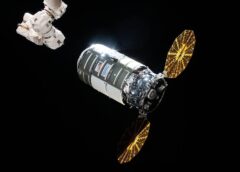Northrop Grumman’s uncrewed Cygnus spacecraft is scheduled to depart the International Space Station on Saturday, Nov. 20, more than three months after delivering nearly 8,000 pounds of supplies, scientific investigations, commercial products, hardware, and other cargo to the orbiting laboratory.

Credits: NASA
Live coverage of the spacecraft’s departure will begin at 10:45 a.m. EST on NASA Television, the agency’s website, and the NASA app.
Flight controllers on the ground will send commands for the space station’s Canadarm2 robotic arm to detach Cygnus from the Unity module’s Earth-facing port. The arm will then maneuver the spacecraft into position and release it at 11 a.m. Astronaut Matthias Maurer of ESA (European Space Agency) will monitor Cygnus’ systems upon its departure from the space station.
After departure, the Kentucky Re-Entry Probe Experiment (KREPE) stowed inside Cygnus will take measurements to demonstrate a thermal protection system for spacecraft and their contents during re-entry in Earth’s atmosphere, which can be difficult to replicate in ground simulations.
Cygnus will deorbit on Wednesday, Dec. 15, following a deorbit engine firing to set up a destructive re-entry in which the spacecraft, filled with waste the space station crew packed in the spacecraft, will burn up in Earth’s atmosphere.
Cygnus arrived at the space station Aug. 12, following a launch two days prior on Northrop Grumman’s Antares rocket from NASA’s Wallops Flight Facility on Wallops Island, Virginia. It was the company’s 16th commercial resupply services mission to the space station for NASA. Northrop Grumman named the spacecraft after NASA astronaut Ellison Onizuka, the first Asian American astronaut.
Learn more about Cygnus’ mission and the International Space Station at:
Get breaking news, images and features from the space station on Instagram, Facebook, and Twitter.


